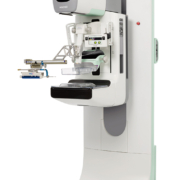DBT makes major stride with Hologic’s launch of innovative mammography system
At the European Society for Breast Imaging (EUSOBI) meeting last September in Berlin, Hologic officially launched the 3Dimensions™ mammography system which offers a variety of groundbreaking features designed to provide higher quality 3D™ images for radiologists, enhanced workflow for technologists, and a more comfortable mammography experience, with low-dose options, for patients (see featured item).
On this occasion, International Hospital talked to Lori Fontaine, Vice President of Clinical Affairs for Hologic.
Is the launch at EUSOBI only for Europe or is it global?
The 3Dimensions™ mammography system received CE Mark in July 2017 making it commercially available in EMEA, followed shortly thereafter by the U.S. launch in August 2017.
Can you give some details and figures on dose reduction for the new system?
We know that dose is a common concern across Europe, and the 3Dimensions system helps address this by providing low-dose options for patients, among many other benefits. The 3Dimensions system results in a 45 percent dose reduction with a generated 2D image compared to 2D FFDM alone.
Is the improvement in image clarity regardless of breast density likely to reduce the need for a secondary ultrasound in the screening of high density breasts?
We already know the 3Dimensions system’s Clarity HD high-resolution 3D™ imaging reduces recalls by up to 40 percent compared to 2D alone, and given Clarity HD works to deliver exceptional 3D™ images, regardless of breast size or density, it makes sense that the 3Dimensions system would be an ideal option for women with dense breasts. This is especially true since the 3Dimensions system operates in tandem with Hologic’s 3D Mammography™ exam, the only mammogram approved by the U.S. Food and Drug Administration as superior for women with dense breasts compared to 2D alone, which further demonstrates that tomosynthesis should be the standard of care for women across the globe when it comes to breast cancer screening.
Do you have any information and figures on the adoption rate of DBT by radiologists in the various European countries, are there significant country variations (or regional between US, Europe and Asia)?
Digital Breast Tomosynthesis (DBT) adoption rates vary by country. While DBT has been approved in EMEA since 2009, the majority of EMEA countries limit the use of DBT to diagnostic imaging as they have concerns regarding dose and reading time. Hologic remains at the forefront of technology innovation and is working to overcome these barriers, so that all women can be screening with DBT.
Hologic was the first company to receive FDA approval for DBT use in both the screening and diagnostic setting in the U.S. in 2011. Today, DBT is used in approximately 40 percent of all U.S. screening mammography exams and is covered by the majority of insurance companies. The evidence of the benefit of Hologic’s 3D Mammography exam as a better mammogram continues to expand and resulted in the addition of DBT to the National Comprehensive Cancer Network (NCCN) Guidelines in 2016. NCCN is recognized globally as an alliance of 27 U.S. cancer centers that develop recommendations designed to help healthcare professionals diagnose, treat and manage cancer care.


